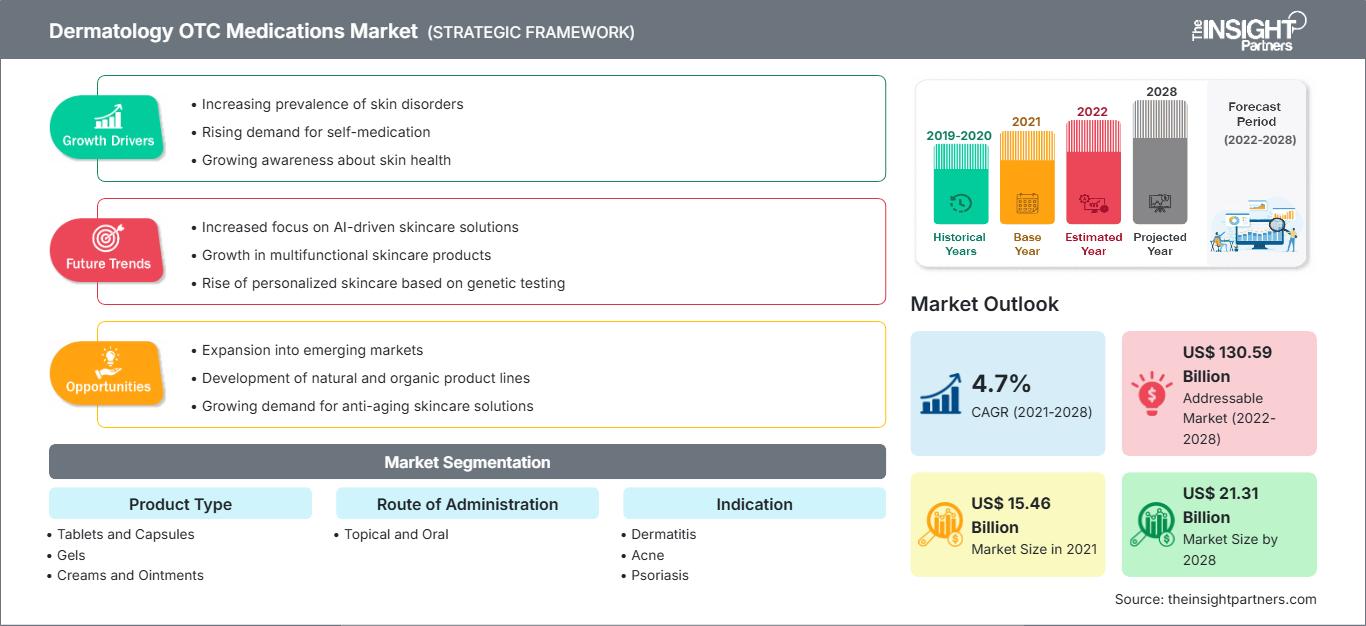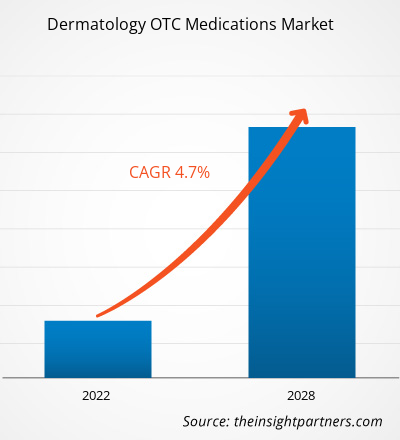[研究报告]皮肤科非处方药市场预计将从2021年的154.5663亿美元增长到2028年的213.1340亿美元;预计2021年至2028年的复合年增长率为4.7%。
皮肤科非处方药直接出售给消费者,无需医疗保健专业人员的处方;而处方药则只能出售给持有有效处方的消费者。非处方药由监管机构甄选,以确保其成分在无需医生指导的情况下使用时安全有效。非处方药通常根据其活性药物成分 (API) 而非最终产品进行监管。通过监管原料药 (API) 而非特定药物配方,政府允许制造商自由地将成分或成分组合配制成专有混合物。
皮肤科非处方药市场根据产品类型、给药途径、适应症、分销渠道和地域进行细分。按地域划分,市场大致分为北美、欧洲、亚太地区、中东和非洲 (MEA) 以及南美洲和中美洲。本报告提供了对市场的深入洞察和分析,重点关注市场趋势、技术进步和市场动态等参数,并分析了全球主要市场参与者的竞争格局。
自定义此报告以满足您的要求
您将免费获得任何报告的定制,包括本报告的部分内容,或国家级分析、Excel 数据包,以及为初创企业和大学提供超值优惠和折扣
皮肤科非处方药市场: 战略洞察

-
获取本报告的主要市场趋势。这个免费样本将包括数据分析,从市场趋势到估计和预测。
市场洞察
皮肤问题高发推动皮肤科 OTC 药物市场增长
皮肤问题高发和中产阶级人口收入的增加预计将推动全球市场增长。然而,OTC 药物的不当使用抑制了皮肤科 OTC 药物市场的增长。色素沉着、皱纹、折痕、痤疮和烧伤疤痕等皮肤问题在人们中很常见。根据美国皮肤病学会 (AADA) 的数据,痤疮是美国最常见的皮肤病,每年影响约 5000 万美国人。此外,约 85% 的 12 至 24 岁人群有轻微痤疮问题。2013 年,与痤疮治疗相关的费用以及接受痤疮治疗的人的生产力损失超过约 12 亿美元;同年,有超过约 510 万人(主要是儿童和青少年)因痤疮寻求医疗治疗。此外,根据美国牙科协会 (AADA) 的数据,十分之一的人会患上特应性皮炎,多达 25% 的儿童和 2% 的成人患有此病。2021 年,根据 Dermstore 对全美 2,000 名女性进行的一项民意调查,年轻女性比老年女性更早开始使用抗衰老产品。此外,欧盟委员会 (EC) 已将皮肤病列为人类疾病的第四大常见原因。寻常痤疮在多个国家/地区日益普遍。皮肤科非处方药被广泛用于治疗痤疮。了解寻常痤疮的负担特征对于开发有效且有针对性的痤疮控制疗法至关重要。根据《2019年全球疾病负担研究》,全球报告的寻常痤疮新发病例为1.174亿例,患病病例为2.312亿例,伤残调整生命年(DALY)为500万年,自1990年以来增长了48%。
皮肤病认知度的提高显著促进了市场增长
皮肤病严重影响发展中国家人民的生活质量,导致工作和学习效率下降,并因毁容而遭受歧视。皮肤的变化也可能预示着需要治疗的更严重的疾病。此前,此类疾病常常被卫生官员忽视或不予重视,因为它们在大多数情况下不会危及生命,而且在三级医疗中心也很少见。
目前,国内外医疗中心必须培训发展中国家的医护人员,以提升皮肤病的诊断和治疗水平。
美国皮肤病学会 (AAD) 已启动多项公众意识提升项目,旨在改善皮肤、头发和指甲的外观。例如,十月是湿疹宣传月,AAD 提供经皮肤科医生认可的信息,帮助人们更好地了解和管理湿疹。美国皮肤协会 (ASA) 2021 年的资助方案现已开放,用于支持杰出的皮肤病研究人员和医生。在过去的 34 年里,ASA 资助了数百项资助,这些资助促成了重要的皮肤病学突破,并提高了人们对皮肤病的认识和了解。因此,人们对皮肤病的认识不断提高,支持了皮肤科非处方药市场的增长。
产品类型洞察
根据产品类型,全球皮肤科非处方药市场分为片剂和胶囊、凝胶、乳膏和软膏以及其他类型。2021 年,乳膏和软膏占据了最大的市场份额。然而,预计片剂和胶囊部分在预测期内的复合年增长率最高。
给药途径洞察
根据给药途径,皮肤科非处方药市场分为外用和口服。2021 年,外用部分占据了更大的市场份额;然而,预计口服药物市场在预测期内的复合年增长率会更高。
适应症洞察
根据适应症,皮肤科 OTC 药物市场细分为皮炎、痤疮、牛皮癣、皮肤漂白、真菌病、疣等。痤疮领域在 2021 年占据了最大的市场份额;预计在预测期内将实现最高的复合年增长率。
分销渠道洞察
根据分销渠道,皮肤科 OTC 药物市场分为线上分销和线下分销。线下分销部分在 2021 年占据了更大的市场份额;然而,预计线上分销部分在预测期内将实现更高的复合年增长率。此外,线下分销部分分为零售和医院药店以及超市和大卖场。零售和医院药房部门在 2021 年占据了更大的市场份额。
产品发布、合并和收购是全球皮肤科非处方药市场参与者高度采用的策略。以下列出了一些近期的关键产品开发:
2020 年 8 月,全球领先的优质平价个人护理产品供应商 Perrigo Company plc 宣布,已从赛诺菲收购了三个东欧 OTC 护肤和脱发治疗品牌(Emolium、Iwostin 和 Loxon)。
2018 年 4 月,Sol-Gel Technologies Ltd. 宣布,该公司是一家临床阶段的皮肤病学公司,专注于识别、开发和商业化用于治疗皮肤病的品牌和仿制外用药物产品。该公司已与 Perrigo Company plc 的附属公司 Perrigo Israel 合作,共同开发、生产和商业化一种仿制候选产品。
新冠疫情给全球医疗保健行业带来了沉重的负担。随着世界经济缓慢复苏,企业的经营方式将永远改变。新冠疫情彻底改变了整个企业格局。多家公司在 2019 年最后一个季度遭受了严重亏损,并对 2020 年第一季度和第二季度产生了负面影响。为确定 SARS-CoV-2 病毒对患者威胁而开展的研发活动可能会减缓皮肤科 OTC 药物市场的增长。因此,COVID-19 疫情对皮肤科 OTC 药物市场的影响是立竿见影且巨大的。由于医疗保健的重点转向拯救生命,COVID-19 疫情爆发导致对皮肤科 OTC 药物的需求减少。COVID-19 疫情正在对全球供应链、消费市场和全球经济造成巨大破坏。由于世界各国政府采取的措施,对皮肤科 OTC 药物的需求可能会暂时大幅下降。因此,疫情对皮肤科 OTC 药物市场产生了不利影响。
皮肤科 OTC 药物 –市场细分
全球皮肤科非处方药市场根据类型、技术、服务和地域进行细分。根据产品类型,市场细分为片剂和胶囊剂、凝胶剂、乳膏剂和软膏剂等。根据给药途径,皮肤科非处方药市场分为外用和口服。根据适应症,皮肤科非处方药市场细分为皮炎、痤疮、牛皮癣、皮肤白斑、真菌病、疣等。根据分销渠道,市场分为线上分销和线下分销。按地域划分,皮肤科非处方药市场大致分为北美、欧洲、亚太地区、中东和非洲以及南美和中美洲。
皮肤科非处方药市场
The Insight Partners 的分析师已详尽阐述了预测期内影响皮肤科非处方药市场的区域趋势和因素。本节还讨论了北美、欧洲、亚太地区、中东和非洲以及南美和中美洲的皮肤科非处方药市场细分和地域分布。
皮肤科非处方药市场报告范围
| 报告属性 | 细节 |
|---|---|
| 市场规模 2021 | US$ 15.46 Billion |
| 市场规模 2028 | US$ 21.31 Billion |
| 全球复合年增长率 (2021 - 2028) | 4.7% |
| 历史数据 | 2019-2020 |
| 预测期 | 2022-2028 |
| 涵盖的领域 |
By 产品类型
|
| 覆盖地区和国家 |
北美
|
| 市场领导者和主要公司简介 |
|
皮肤科非处方药市场参与者密度:了解其对业务动态的影响
皮肤科非处方药市场正在快速增长,这得益于终端用户需求的不断增长,而这些需求的驱动因素包括消费者偏好的不断变化、技术进步以及对产品益处的认知度不断提高。随着需求的增长,企业正在扩展产品线,不断创新以满足消费者需求,并抓住新兴趋势,从而进一步推动市场增长。

- 获取 皮肤科非处方药市场 主要参与者概述
公司简介
- Bausch Health Companies Inc.
- Perrigo Company plc
- Bayer AG
- Viatris Inc.
- Johnson and Johnson Services, Inc.
- LEO Pharma A/S
- GlaxoSmithKline plc.
- Galderma
- Dr. Reddy's Laboratories
- ACELLA PHARMACEUTICALS, LLC
- 历史分析(2 年)、基准年、预测(7 年)及复合年增长率
- PEST和SWOT分析
- 市场规模、价值/数量 - 全球、区域、国家
- 行业和竞争格局
- Excel 数据集
近期报告
客户评价
购买理由
- 明智的决策
- 了解市场动态
- 竞争分析
- 客户洞察
- 市场预测
- 风险规避
- 战略规划
- 投资论证
- 识别新兴市场
- 优化营销策略
- 提升运营效率
- 顺应监管趋势






















 获取免费样品 - 皮肤科非处方药市场
获取免费样品 - 皮肤科非处方药市场